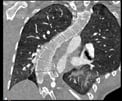
iDose, courtesy of Philips Healthcare
While computed tomography (CT) has revolutionized medical imaging, it has also required much higher doses of ionizing radiation than was previously used in traditional X-ray imaging. In recent years, vendors have turned their attention to developing technology to drastically reduce dose. Some of the reduction stratgies are using techniques like tube modulation. More recent advances include development of iterative reconstruction software to produce diagnostic-quality images from lower-dose scans. The software works by applying algorithms to remove noise for low-dose image reconstruction to improve clarity.
Members of the Medical Imaging and Technology Alliance (MITA), an organization of medical imaging equipment manufacturers, now incorporate the key radiation dose management mantra of As Low As Reasonably Achievable (ALARA). MITA has set guidelines through its CT Dose Check Initiative for developing better dose-management techniques. In addition, suggested guidelines for dose reduction have come from the Joint Commission, the Image Wisely (www.imagewisely.org) and Image Gently (www.imagegently.org) campaigns, the American College of Radiology (ACR) and the American Association of Physicists in Medicine (AAPM).
The emphasis on dose reduction was accelerated when California became the first state to enact a law requiring radiologists to record all radiation doses delivered to patients, starting July 1, 2012. Other states are expected to enact similar reporting requirements. Recording dose and including it in the electronic medical record (EMR) will become more important in the future.
New Iterative Reconstruction Software
In September 2011, GE introduced Veo, which applies new modeling techniques to deliver lower noise, increased resolution, improved low-contrast detectability and fewer artifacts for overall improved image clarity. GE said the software is the first model-based iterative reconstruction (MBIR) technique. Veo users in Europe report chest CTs done with an equivalent amount of radiation dose as a chest X-ray, or less than 0.1 millisievert (mSv).
GE Healthcare’s ASiR (adaptive statistical iterative reconstruction) low-dose reconstruction technology is available on a variety of GE imaging platforms. It is used on more than 800 scanners worldwide.
At RSNA 2011, Toshiba unveiled Adaptive Iterative Dose Reduction 3D (AIDR 3D) technology. Still pending 510(k) approval from the U.S. Food and Drug Administration (FDA), the software will be available on Toshiba’s Aquilion One, Aquilion Premium and Aquilion Prime systems. It lowers dose using a sophisticated algorithm designed to work in both the raw data and image data space, reducing noise to maintain image quality. The AIDR 3D software integrates with SUREExposure 3-D, software that calculates the minimum radiation exposure required for every exam. It adjusts dose for each patient based on a pre-set, targeted level of image quality.
Toshiba’s new Aquilion Prime offers Nema XR 25 Dose Check. The software enhances user awareness of the radiation being administered to patients. It includes dose alert and dose notification, addressing the two main components of MITA’s CT Dose Check Initiative.
Philips reports it has more than 500 installs for iDose, the latest generation of its iterative reconstruction technique. It gives radiologists control of the dial so they can personalize image quality depending on clinical needs at low dose. It can be used in combination with the iCT, Ingenuity and Brilliance 64 scanner families. The system lets radiologists personalize image quality based on each patient’s specific needs.
Siemens launched several new reconstruction software packages last year, including FAST CARE and a raw data-based iterative reconstruction called SAFIRE (sinogram affirmed iterative reconstruction). With SAFIRE, raw data are utilized in the iterative image improvement process. The software performs multiple iterative loops in the raw-data domain and then corrects geometrical imperfections. It reconstructs images from this “corrected” raw data.
Siemens’ Iterative Temporal Resolution Improvement Method (iTRIM) employs an iterative image reconstruction algorithm to raise overall image quality in cardiac examinations and curbs noise. This results in a 195-millisecond temporal resolution. Motion artifacts are reduced, enabling accurate diagnosis, even during a rapid heartbeat.
Siemens’ CARE (Combined Applications to Reduce Exposure) Dose 4-D adapts the X-ray tube current in real time for the entire scan. This ensures consistently high image quality while keeping dose as low as possible for all organs and types of anatomy.
Dose Management Software
At RSNA 2011, Siemens unveiled the Somatom Perspective. It is the first CT scanner to offer the eMode software solution, which helps determine the best correlation between dose, efficiency and image quality; it can also adjust the required scan parameters automatically. The system’s operation can be optimized for the individual scan, in terms of tube current or scan velocity. This allows the scanner to operate with as low a load as possible, minimizing wear, and it also increases the scanner’s life cycle.


 December 10, 2025
December 10, 2025 









